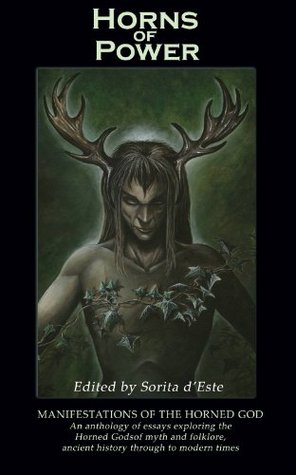More on this book
Kindle Notes & Highlights
Before we can continue we need to clarify the difference between horns and antlers. Antlers are bone extrusions which grow from the heads of most species of deer, and are shed annually. Horns are also bony extrusions, but unlike antlers they are covered with the hard protein substance keratin. Horns are not shed, and grow continuously with the addition of new tissue at the base of the horns.
The first piece of evidence for Cernunnos is the altar carving found in Notre Dame in Paris in 1710 CE which reads ‘ERNUNNO’, with the first and last letters lost through erosion. This carving from 17CE does not seem to show an antlered god, as Cernunnos is popularly perceived today, but rather a god with shorter horns. There has been speculation that the horns seen on this image are in fact those of a bull, rather than those of a stag.
However, when considering that the name and its variants mean Horned One, and looking at the diversity in images, is it perhaps more likely that Cernunnos was a title, and that as such it might have been used to refer to any horned god? Using a title for a deity name was a common practice as can be seen by looking at the names of other well known Celtic deities. For example: Morrigán (‘Great Queen’), Daghda (‘Good God’), Epona (‘Divine Horse’) and Ialonus (‘God of the Glade’). It might also be that it was a term used for a class of spiritual beings, for example the Matres (‘Mothers’) and
...more
As well as being linked to animals and thus nature, the occurrence of coins or bags of coins in images of Cernunnos, such as may be next to the god’s head in the relief found at Cirencester, and in a stela found at Reims in France, point to a wealth connection as well. This association with wealth would explain why Julius Caesar chose to associate him with Dis Pater (‘the Wealthy Father’) rather than the more common Roman association of Cernunnos with Mercury.
The tragedy of Herne played out in the reign of Richard II, twenty-three years full of strife, ruled over by a young King who some say was badly advised. Richard II came to the throne in 1377 when he was ten years old, and reigned until he died in 1400, his throne usurped and he a prisoner.
As Herne lay bleeding the King called for his physician, but he was back at the castle. No-one could help and the King watched on helpless as Herne lay dying. Then, as if from nowhere, a man on a black horse appeared from behind a large beech tree. Philip Urswick, for such he called himself, introduced himself to the King and offered his services. Some cried he must be a poacher, out after the stag himself, but others recognised him and told the King of his deeds. For Urswick was a wizard, who dwelled nearby on Bagshot Heath, though being black clad on a black horse there were some who
...more
This highlight has been truncated due to consecutive passage length restrictions.
Herne is also said to appear when the sovereign of Britain is near to death, or is unjust, or when the nation is in danger.
Unlike the aloof Apollo, Pan not only leads the dance as choregos, but also joins in with the other dancers.
In 1965 the classic work The Roman Inscriptions of Britain (RIB) was published, marking a landmark in archaeological collation. This book gathered together all the inscriptions made during the Roman occupation of Britain. Studying such inscriptions reveals much about this occupation of Britain, including some interesting facts about the gods worshipped during this period. Amongst the inscriptions are ninety-four inscriptions to five horned gods. These horned gods, worshipped by the Celts, were Antenocitus (three), Belatucadros (twenty-six), Camulos (one), Cocidius (twenty-four), and Vitiris
...more
Camulos is a ram-horned god whose name means ‘the Powerful One’. He is originally from Belgium, and though there is only one inscription, and a plaque mentioned earlier, coins dedicated to him have also been found around Colchester in Essex, and there are also old place names which were associated with him. These are Camulodunum (meaning ‘Fort of Camulos’), the old name for Colchester; Cambodunum, now Slack in Yorkshire; and Camulosessa (‘Seat of Camulos’) in southern Scotland.
The serpent is a creature of contrasts, revered and reviled, bringer of wisdom and temptation. The horned serpent is the same, being viewed in different cultures as a force of great power and conversely of destructive chaos. I have always been fascinated by snakes, so the motif of the horned serpent was one I had to explore. Beyond the initial image of Cernunnos with his ram-headed serpent in Celtic artwork, I soon found horned serpents all around the world.
Pliny the Elder introduced the name monoceros (‘one horn’) for the unicorn in his writings.
the wild side of the unicorn was emphasised by the German artist Albrecht Durer (1471-1528) in his 1516 engraving The Rape of Persephone, which shows Hades abducting Persephone on the back of a unicorn rather than in a chariot.
Sunlight penetrating darkness is not always gentle, it can be cruel and inevitable. It is certainly invincible, always winning the preliminary fight of pre-dawn before the flaming spear of the first rays explode over the horizon. At the famous site of New Grange in Ireland, where sunlight enters the long tunnel and illuminates the chamber on the Winter Solstice, it has been described as slicing into the darkness quickly and devastatingly – “like a sword” rather than a slow rosy glow.


